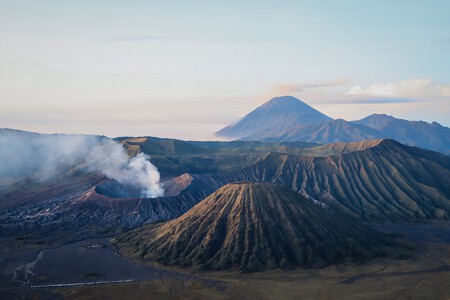Under a scorching sun and enveloped by a cloud of dust, thousands of people walk along the edge of the basin of the mount bromo, an active volcano in Tengger, Indonesia. They drag animals such as cows, goats and chickens with them and carry vegetables and other products on their backs. They are not nomads moving to another place, but they are performing a hindu ritual characteristic of the region consisting of dump all that cattle and food into the crater steaming from a volcano in the hope of pleasing their gods and gaining fortune.
Most of them are Tenggerese, an indigenous people who live on the slopes of this volcano in East Java province and celebrate the Yadnya Kasada festival every year. Climb to the top to look into the sulfuric abyss it will take 30 minutesa journey where the wind is relentless and the very steep path. Loaded down with their offerings, many of them stumble and bump into one another. But nothing stops them from making their offerings.
In This TikTok video Made by the AFP agency, you can see in detail how the festival takes place and what the ascent to the volcano consists of:
@logan_govender Hindu Worshipers on Active Indonesian Volcano for Ritual Sacrifices, offering Food & Livestock.
Indonesia has more than 120 active volcanoes, along with dozens of others that are now inactive or extinct. On Java, the country’s most populous island, a range of volcanoes stretches from east to west (about 1,000 kilometers long), giving rise to villages that live and cultivate their livelihood in this fertile volcanic soil.
And Mount Bromo, where all this agglomeration of people is located, is one of them. Named after Brahma, the Hindu god of creation, it is an active volcano in Bromo Tengger Semeru National Park. Its height is high: 2.3 kilometers. The last time it erupted was in the summer of 2019, causing tremors in the area and terrifying its inhabitants. Even so, the ritual is celebrated religiously every year, regardless of their status, because contenting those of the afterlife is paramount.
“We have a lot of cows at home and this can be considered excess, so we are bringing it here… to give it back to God,” explained a villager in This report from The New York Times. Another farmer, aged 36, who brought farm products such as cabbages and carrots to throw them into the steaming void and said that he hopes “to receive a reward from Almighty God”. Another merchant who, in addition to throwing potatoes and leeks, threw cash into the ditch, said that his business “had gone better after his visits to the volcano.”
It has its origin in a legend
To understand the origins of this ritual, one must go back to the 15th century and regional folklore, to stories that were passed down from generation to generation in the kingdom of Majapahit, a Hindu-Buddhist empire from Java that stretched across Southeast Asia.
Legend says that a princess, Roro Anteng, and her husband were unable to have children years after their marriage, so they begged the gods for help. Their prayers were heard and they were promised 25 children, as long as they accepted sacrifice his youngest son throwing it into Mount Bromo. It is said that his son voluntarily jumped into the volcano to ensure the prosperity of the Tengger people.
The celebration, today, begins in a temple near the crater at two in the morning, where thousands of people gather at its gates. after the songs and prayers From the Tengger shamans, all the pilgrims begin their ascent to the edge of the volcano while lighting incense and chanting different mantras. Then, one by one, they begin to throw their “gifts” into the crater.
But be careful, because some villagers, who do not belong to the Tengger tribe and do not believe in this religious ritual, also go to try to catch all those offerings with nets before they fall at the bottom of the volcano. This is not part of the festival, but they are people who do not want waste food nor the animals that could support hundreds of people each year.
Over time, this celebration has become a tourist attraction that the local government itself promotes. And not only is this animal sacrifice carried out, but activities and musical shows are scheduled to teach visitors the regional culture. Those who have not been horrified by such an atrocity, of course.
Images: Unsplash | flickr (john fleischman)
Video: AFP TikTok account
In Xataka | Thousands of supereruptions over 500 million years on Mars: NASA finds evidence of a volcanic macroevent on Mars















